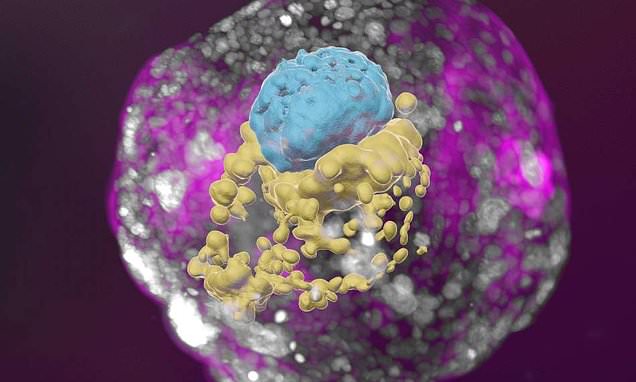Scientists grow artificial embryo model without using sperm, an egg or a WOMB in world-first – and it tested positive on a pregnancy test
- Researchers at the Weizmann Institute of Science in Israel used lab stem cells
- They hope it will allow scientists to ethically find out what happens to an embryo
- READ MORE: Record number of US women getting pregnant in their 50s
Scientists have grown an entity very close to a human embryo — without using sperm, eggs or a womb.
The embryo even released hormones which turned a pregnancy test positive in the laboratory.
Researchers at the Weizmann Institute of Science in Israel made the complete models of human embryos from stem cells generated in the lab, after building on previous research where they had made mouse embryos.
Professor Jacob Hanna, who led the research team, said: ‘The drama is in the first month; the remaining eight months of pregnancy are mainly lots of growth.’

Pictured: the 14-day embryo, including the yolk sac (yellow) and the part that will become the embryo itself, topped by the membrane (blue) — all enveloped by cells that will become the placenta (pink)
The artificial embryo model had all of the elements that a 14-day human embryo would be expected to have, including the placenta, yolk sac, membranes and other external tissues.
The hope is that the model will allow researchers to ethically work out what happens during a human embryo’s first few weeks after a sperm fertilizes an egg.
Lots of miscarriages and birth defects occur in this period, but currently, little is understood about it.
Professor Hanna said: ‘That first month is still largely a black box. Our stem cell–derived human embryo model offers an ethical and accessible way of peering into this box.
‘It closely mimics the development of a real human embryo, particularly the emergence of its exquisitely fine architecture.’
Until now, models of human embryos have not been accurate as they have not contained cell types that are crucial for the embryo’s development, including cells to make up the placenta and membrane.
They also did not grow beyond the 14-day mark.
The research was published today in the journal Nature.
Source: Read Full Article



